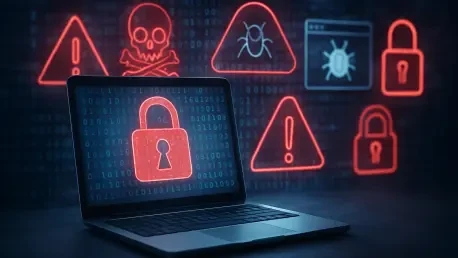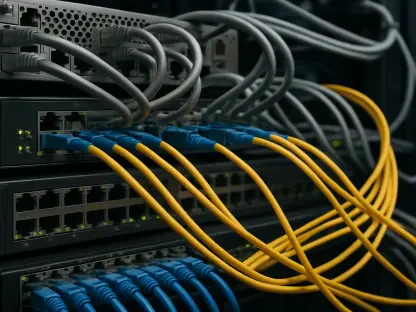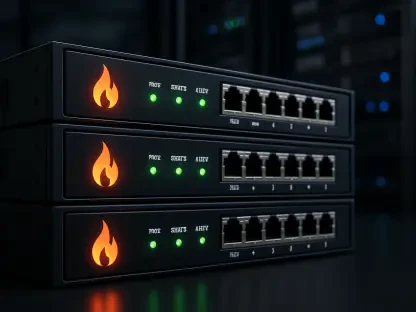In an era where digital transformation dictates the pace of business, the architecture of networks is undergoing a seismic shift, driven by the urgent need to counter escalating cyber threats, accommodate remote work, and embrace cloud technologies, while traditional security models, once reliant on a fortified perimeter, are proving inadequate against sophisticated attacks targeting distributed workforces and multi-cloud environments. The concept of “secure by design” has emerged as a critical philosophy, advocating for security to be embedded into the very core of network infrastructure rather than applied as an afterthought. This approach is not merely a trend but a necessity, as organizations navigate a landscape where data breaches can cripple operations overnight. The stakes are immense, with businesses now tasked with protecting a vast, interconnected web of users and devices spread across global locations. This article explores the pivotal elements of this transformation, drawing on expert insights to outline a path toward resilient, future-ready networks.
The urgency of this shift cannot be overstated. Cyberattacks are not only increasing in frequency but also in complexity, exploiting gaps in outdated systems that fail to account for today’s dynamic environments. Designing networks with inherent security offers a proactive defense, anticipating risks before they manifest. Beyond technology, this requires a fundamental change in mindset, where security becomes a priority for every level of an organization. The days of assuming safety within a defined boundary are long gone; threats can emerge from any direction, at any moment. This reality compels a reevaluation of how networks are built and maintained, ensuring they are equipped to handle both current and emerging challenges.
Moreover, the cultural dimension of this transformation is as significant as the technological one. Adopting a security-first approach demands commitment from leadership to dismantle long-standing assumptions and invest in comprehensive strategies. Resistance to change often poses a barrier, alongside fragmented policies and insufficient funding. Yet, overcoming these obstacles is vital for survival in a digital economy where trust and reliability are paramount. As the discussion unfolds, it becomes clear that the future hinges on integrating innovative principles and practical solutions to create networks that are both powerful and protected.
Core Principles of Secure-by-Design Networking
Zero Trust: Redefining Security Boundaries
The principle of zero trust has risen as a cornerstone of modern network security, rooted in the idea that no user, device, or workload should be inherently trusted, regardless of location. This approach discards the outdated notion of a secure perimeter, recognizing that in today’s distributed environments, threats can originate from within as easily as from outside. Continuous verification becomes the norm, ensuring that every access request is authenticated and authorized. Industry experts highlight that zero trust is more than a set of tools; it represents a cultural pivot that challenges traditional thinking. Leadership must drive this change, fostering an environment where identity, rather than location, defines the security boundary. Without this shift, organizations remain vulnerable to breaches that exploit outdated trust models, risking significant operational and reputational damage.
Implementing zero trust, however, is not without its hurdles. Managing identities across sprawling networks and segmenting access to minimize risk are complex tasks that often meet resistance. Underinvestment in critical areas like identity and access management (IAM) compounds the problem, as does a reluctance to abandon familiar practices. Despite these challenges, the consensus among specialists is unequivocal: zero trust is a non-negotiable strategy for survival in a threat-laden digital world. Success depends on pairing technological solutions with a willingness to adapt organizational mindsets. By prioritizing identity as the new perimeter, businesses can build a foundation that withstands evolving risks, ensuring that security evolves in tandem with their operations.
Identity as the New Perimeter
Beyond the conceptual framework, zero trust demands practical steps to redefine how access is controlled within networks. Identity management stands at the forefront, requiring robust systems to authenticate and monitor every interaction continuously. This shift means that even employees within a corporate network are subject to the same scrutiny as external users, eliminating blind spots that attackers often exploit. The complexity of managing diverse identities—across employees, contractors, and devices—poses a significant challenge, especially in large organizations with legacy infrastructure. Experts stress that investment in scalable IAM solutions is essential to handle this intricacy, alongside training to ensure staff understand the importance of strict access protocols.
Additionally, network segmentation plays a vital role in operationalizing zero trust principles. By dividing networks into smaller, isolated zones, organizations can limit the spread of a breach if one occurs. This granular approach, while effective, requires meticulous planning to avoid disrupting workflows or creating overly restrictive environments. Balancing security with operational efficiency is a recurring theme, as overly stringent controls can lead to user frustration and non-compliance. The path forward involves leveraging automation to streamline verification processes, reducing human error and enhancing responsiveness. Through such measures, zero trust transforms from an ideal into a tangible, actionable framework that fortifies network resilience.
Practical Frameworks for Implementation
SASE and SSE: Integrating Security and Connectivity
Secure Access Service Edge (SASE) and Security Service Edge (SSE) represent transformative cloud-native frameworks that merge networking and security into a unified architecture. Designed to address the needs of distributed workforces, these solutions ensure consistent policy enforcement whether users are in a central office or working remotely from distant locations. By integrating capabilities like secure web gateways and firewall-as-a-service, SASE and SSE provide a seamless shield across diverse environments. Experts note that these frameworks are particularly valuable in leveraging AI for advanced threat detection and automated policy management, offering a dynamic response to evolving risks. As businesses increasingly rely on cloud infrastructure, adopting such architectures becomes a critical step in maintaining both security and connectivity.
However, transitioning to SASE and SSE is not a straightforward process. Challenges such as policy sprawl—where overlapping rules create confusion—and compatibility issues with existing applications often arise during implementation. User experience also plays a pivotal role; if security measures are perceived as cumbersome, employees may seek workarounds, undermining the entire system. Striking a balance between robust protection and usability is essential for success. Industry insights suggest that automation and centralized oversight can mitigate these issues, simplifying policy management and reducing friction. By focusing on streamlined integration, organizations can harness the full potential of SASE and SSE to protect their networks without sacrificing operational efficiency.
Overcoming Migration Challenges
Delving deeper into the adoption of SASE and SSE, the migration process itself presents a unique set of obstacles that must be carefully navigated. One significant issue is the complexity of aligning new cloud-based frameworks with legacy systems, which often lack the flexibility to support modern security protocols. This mismatch can lead to gaps in coverage or performance bottlenecks, requiring thorough testing and phased rollouts to ensure compatibility. Additionally, policy conflicts during integration can create vulnerabilities if not addressed promptly. Experts advocate for a detailed inventory of existing policies and applications before migration begins, allowing for a smoother transition that minimizes disruptions to business operations.
Another critical aspect is training and change management to support staff through the shift to these new architectures. Resistance often stems from unfamiliarity with cloud-native tools or concerns over workflow interruptions. Providing clear communication about the benefits—such as enhanced security and remote access—can help alleviate these concerns. Furthermore, leveraging vendor support and pilot programs can identify potential issues early, refining the deployment strategy. Automation tools also prove invaluable in managing the increased complexity, ensuring policies are enforced consistently without overwhelming IT teams. Through a strategic, well-supported approach, the hurdles of adopting SASE and SSE can be transformed into stepping stones toward a more secure network infrastructure.
Preparing for Emerging Threats
Quantum-Safe Networking: Planning for Tomorrow
As technology advances, quantum computing emerges as a potential disruptor to current encryption standards, posing risks that could undermine data security in the years ahead. Although fully functional quantum computers are not yet a reality, the concept of “harvest now, decrypt later” attacks—where adversaries store encrypted data for future decryption—presents a pressing concern. Sectors like finance, healthcare, and government, which manage sensitive information with long-term value, are particularly vulnerable. Addressing this threat requires forward-thinking strategies that prioritize preparation over reaction. Experts emphasize the importance of staying ahead of this curve by building resilience into cryptographic systems now, ensuring that data remains protected against future breakthroughs.
The concept of “crypto-agility” offers a practical path forward, enabling organizations to adapt their encryption protocols swiftly as new risks emerge. This involves cataloging current cryptographic assets to understand exposure levels and testing quantum-resistant algorithms, such as those being standardized by NIST. A hybrid approach, combining existing methods with emerging quantum-safe techniques, provides a balanced strategy that avoids premature overhauls while enhancing security. Regulatory compliance also plays a role, as industries face increasing pressure to adopt future-proof standards. By taking measured steps today, businesses can mitigate the impact of quantum advancements, safeguarding their most critical assets for the long term without disrupting current operations.
Building a Resilient Cryptographic Foundation
Beyond initial planning, establishing a resilient cryptographic foundation for quantum-safe networking requires sustained effort and collaboration across sectors. Engaging with industry consortia and research bodies helps organizations stay informed about the latest developments in quantum-resistant technologies, ensuring they are not caught off guard by rapid advancements. Piloting new algorithms in non-critical systems allows for real-world testing, identifying potential weaknesses before full deployment. This proactive stance also aids in aligning with evolving standards, which are crucial for interoperability in a globally connected ecosystem.
Equally important is the integration of cryptographic updates into broader security strategies, ensuring they complement existing frameworks like zero trust and SASE. This holistic approach prevents silos that could weaken overall defenses. Education remains a key component, as IT teams must understand the implications of quantum threats and the tools available to counter them. Partnerships with technology providers can facilitate access to cutting-edge solutions, easing the transition to quantum-safe practices. By embedding flexibility and foresight into their security posture, organizations can navigate the uncertainties of quantum computing, maintaining trust and stability in an unpredictable digital landscape.
The Vision of Seamless Security
Convergence of Security Technologies
The trajectory of networking points toward a convergence of diverse security technologies into a cohesive, resilient framework that integrates zero trust, SASE/SSE, and quantum-safe methodologies. Experts anticipate that over the next few years, these elements will no longer operate in isolation but as interconnected facets of a comprehensive security continuum. The incorporation of AI for policy enforcement and threat prediction, alongside quantum key management, will further enhance this integration. Such convergence aims to erase the traditional boundaries between security and networking operations, creating systems where protection is inherent and automatic. This unified approach promises to streamline defenses, reducing vulnerabilities that arise from fragmented strategies.
This merging of technologies also underscores the growing importance of automation in managing complex network environments. As security becomes embedded into every layer, automated systems will handle tasks like real-time threat response and policy updates, minimizing human intervention and error. This shift not only boosts efficiency but also allows IT teams to focus on strategic initiatives rather than routine maintenance. The vision of a converged framework aligns with broader trends in cloud-native infrastructure, where flexibility and scalability are paramount. By embracing this integrated model, organizations can build networks that are robust yet adaptable, ready to meet the demands of an ever-changing threat landscape.
Invisible Security: Protection Without Disruption
Central to the future of networking is the concept of “invisible security,” where protective measures operate seamlessly in the background without impeding productivity or user experience. This ideal envisions a network where users are unaware of the sophisticated defenses at work, experiencing only the benefits of secure, uninterrupted access. Achieving this requires a delicate balance of advanced technology and thoughtful design, ensuring that security enhances rather than obstructs business processes. Experts argue that invisible security is the ultimate goal of the secure-by-design philosophy, aligning protection with operational goals to create an environment of trust and efficiency.
Realizing this vision demands not only technological innovation but also a cultural evolution within organizations. Security must be ingrained into the fabric of daily operations, becoming a natural extension of how networks function rather than a separate layer. This involves refining user interfaces to minimize friction and leveraging automation to handle complex tasks discreetly. The success of invisible security hinges on collaboration between IT teams and business units to prioritize both safety and usability. As this concept takes hold, it paves the way for networks that empower growth and innovation, proving that robust defense can coexist with seamless functionality in the digital age.
Reflecting on a Security-First Legacy
Looking back, the journey toward secure-by-design networking marked a pivotal era in how digital infrastructure was reimagined. Organizations that embraced zero trust, adopted frameworks like SASE and SSE, and prepared for quantum threats laid a foundation of resilience that shaped their ability to withstand evolving risks. Challenges such as cultural resistance and policy complexities were met with determination, driven by leadership committed to prioritizing security at every level. The integration of these strategies into a unified, automated framework redefined what networks could achieve, balancing protection with performance in ways that once seemed unattainable. As this transformation unfolded, it became evident that embedding security into design was not just a response to threats but a proactive step toward sustainable innovation. The next horizon involves harnessing programmability and automation, ensuring that networks continue to evolve as dynamic, secure enablers of progress.









